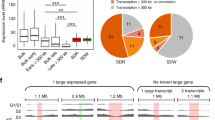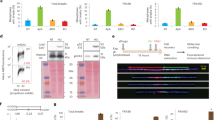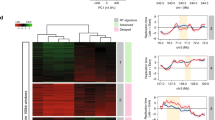Abstract
Common fragile sites have long been identified by cytogeneticists as chromosomal regions prone to breakage upon replication stress1. They are increasingly recognized to be preferential targets for oncogene-induced DNA damage in pre-neoplastic lesions2 and hotspots for chromosomal rearrangements in various cancers3. Common fragile site instability was attributed to the fact that they contain sequences prone to form secondary structures that may impair replication fork movement, possibly leading to fork collapse resulting in DNA breaks4. Here we show, in contrast to this view, that the fragility of FRA3B—the most active common fragile site in human lymphocytes—does not rely on fork slowing or stalling but on a paucity of initiation events. Indeed, in lymphoblastoid cells, but not in fibroblasts, initiation events are excluded from a FRA3B core extending approximately 700 kilobases, which forces forks coming from flanking regions to cover long distances in order to complete replication. We also show that origins of the flanking regions fire in mid-S phase, leaving the site incompletely replicated upon fork slowing. Notably, FRA3B instability is specific to cells showing this particular initiation pattern. The fact that both origin setting5,6 and replication timing are highly plastic7,8 in mammalian cells explains the tissue specificity of common fragile site instability we observed. Thus, we propose that common fragile sites correspond to the latest initiation-poor regions to complete replication in a given cell type. For historical reasons, common fragile sites have been essentially mapped in lymphocytes1. Therefore, common fragile site contribution to chromosomal rearrangements in tumours should be reassessed after mapping fragile sites in the cell type from which each tumour originates.
This is a preview of subscription content, access via your institution
Access options
Subscribe to this journal
Receive 51 print issues and online access
$199.00 per year
only $3.90 per issue
Buy this article
- Purchase on Springer Link
- Instant access to full article PDF
Prices may be subject to local taxes which are calculated during checkout



Similar content being viewed by others
References
Sutherland, G. R. & Richards, R. I. The molecular basis of fragile sites in human chromosomes. Curr. Opin. Genet. Dev. 5, 323–327 (1995)
Negrini, S., Gorgoulis, V. G. & Halazonetis, T. D. Genomic instability—an evolving hallmark of cancer. Nature Rev. Mol. Cell Biol. 11, 220–228 (2010)
Bignell, G. R. et al. Signatures of mutation and selection in the cancer genome. Nature 463, 893–898 (2010)
Schwartz, M., Zlotorynski, E. & Kerem, B. The molecular basis of common and rare fragile sites. Cancer Lett. 232, 13–26 (2006)
Grégoire, D., Brodolin, K. & Méchali, M. HoxB domain induction silences DNA replication origins in the locus and specifies a single origin at its boundary. EMBO Rep. 7, 812–816 (2006)
Dazy, S., Gandrillon, O., Hyrien, O. & Prioleau, M. N. Broadening of DNA replication origin usage during metazoan cell differentiation. EMBO Rep. 7, 806–811 (2006)
Hansen, R. S. et al. Sequencing newly replicated DNA reveals widespread plasticity in human replication timing. Proc. Natl Acad. Sci. USA 107, 139–144 (2010)
Hiratani, I. et al. Global reorganization of replication domains during embryonic stem cell differentiation. PLoS Biol. 6, e245 (2008)
Tourriere, H. & Pasero, P. Maintenance of fork integrity at damaged DNA and natural pause sites. DNA Repair 6, 900–913 (2007)
Branzei, D. & Foiani, M. Maintaining genome stability at the replication fork. Nature Rev. Mol. Cell Biol. 11, 208–219 (2010)
Durkin, S. G. & Glover, T. W. Chromosome fragile sites. Annu. Rev. Genet. 41, 169–192 (2007)
Helmrich, A., Stout-Weider, K., Hermann, K., Schrock, E. & Heiden, T. Common fragile sites are conserved features of human and mouse chromosomes and relate to large active genes. Genome Res. 16, 1222–1230 (2006)
Tsantoulis, P. K. et al. Oncogene-induced replication stress preferentially targets common fragile sites in preneoplastic lesions. A genome-wide study. Oncogene 27, 3256–3264 (2008)
Palumbo, E., Matricardi, L., Tosoni, E., Bensimon, A. & Russo, A. Replication dynamics at common fragile site FRA6E . Chromosoma (2010)
Huebner, K. & Croce, C. M. Cancer and the FRA3B/FHIT fragile locus: it’s a HIT. Br. J. Cancer 88, 1501–1506 (2003)
Pichiorri, F. et al. Molecular parameters of genome instability: roles of fragile genes at common fragile sites. J. Cell. Biochem. 104, 1525–1533 (2008)
Lebofsky, R., Heilig, R., Sonnleitner, M., Weissenbach, J. & Bensimon, A. DNA replication origin interference increases the spacing between initiation events in human cells. Mol. Biol. Cell 17, 5337–5345 (2006)
Cha, R. S. & Kleckner, N. ATR homolog Mec1 promotes fork progression, thus averting breaks in replication slow zones. Science 297, 602–606 (2002)
Rothstein, R., Michel, B. & Gangloff, S. Replication fork pausing and recombination or “gimme a break”. Genes Dev. 14, 1–10 (2000)
Farkash-Amar, S. et al. Global organization of replication time zones of the mouse genome. Genome Res. 18, 1562–1570 (2008)
Anglana, M., Apiou, F., Bensimon, A. & Debatisse, M. Dynamics of DNA replication in mammalian somatic cells: nucleotide pool modulates origin choice and interorigin spacing. Cell 114, 385–394 (2003)
Courbet, S. et al. Replication fork movement sets chromatin loop size and origin choice in mammalian cells. Nature 455, 557–560 (2008)
Bielinsky, A. K. Replication origins: why do we need so many? Cell Cycle 2, 307–309 (2003)
El Achkar, E., Gerbault-Seureau, M., Muleris, M., Dutrillaux, B. & Debatisse, M. Premature condensation induces breaks at the interface of early and late replicating chromosome bands bearing common fragile sites. Proc. Natl Acad. Sci. USA 102, 18069–18074 (2005)
Le Beau, M. M. et al. Replication of a common fragile site, FRA3B, occurs late in S phase and is delayed further upon induction: implications for the mechanism of fragile site induction. Hum. Mol. Genet. 7, 755–761 (1998)
Durkin, S. G. et al. Replication stress induces tumor-like microdeletions in FHIT/FRA3B. Proc. Natl Acad. Sci. USA 105, 246–251 (2008)
Ryba, T. et al. Evolutionarily conserved replication timing profiles predict long-range chromatin interactions and distinguish closely related cell types. Genome Res. 20, 761–770 (2010)
O’Keefe, L. V. & Richards, R. I. Common chromosomal fragile sites and cancer: focus on FRA16D. Cancer Lett. 232, 37–47 (2006)
Masai, H., Matsumoto, S., You, Z., Yoshizawa-Sugata, N. & Oda, M. Eukaryotic chromosome DNA replication: where, when, and how? Annu. Rev. Biochem. 79, 89–130 (2010)
Michalet, X. et al. Dynamic molecular combing: stretching the whole human genome for high-resolution studies. Science 277, 1518–1523 (1997)
Labit, H. et al. A simple and optimized method of producing silanized surfaces for FISH and replication mapping on combed DNA fibers. Biotechniques 45, 649–658 (2008)
R Development Core Team. R: A Language and Environment for Statistical Computing (R Foundation for Statistical Computing, 2006)
Acknowledgements
We thank E. Blackburn for critical reading of the manuscript. We thank Genomic Vision for making the DNA combing technology available to us. We acknowledge the Nikon Imaging Centre at Institut Curie-CNRS. We thank C. Rouzaud for help in combing experiments. A.L. is supported by a grant from the ARC (Association pour la recherche sur le cancer). The M.D. team is supported by La Ligue Nationale contre le Cancer (LNCC) (Equipe Labellisée EL2008.LNCC/MD), INCa (Institut National du Cancer) (2009-1-PLBIO-10-IC-1) and the PIC Réplication, Instabilité Chromosomique et Cancer (Institut Curie).
Author information
Authors and Affiliations
Contributions
A.L. performed and analysed combing experiments. G.A.M. performed statistical and Repli-Seq analyses. S.K., A.-M.L. and O.B. performed cytogenetic analyses. N.V. and B.M. designed the Morse code. R.S.H. contributed to Repli-Seq analysis. A.L., G.A.M., O.B. and M.D. wrote the paper. M.D. planned the project.
Corresponding author
Ethics declarations
Competing interests
The authors declare no competing financial interests.
Supplementary information
Supplementary Information
The file contains Supplementary Figures 1-9 with legends and Supplementary Tables 1-4. (PDF 2012 kb)
Rights and permissions
About this article
Cite this article
Letessier, A., Millot, G., Koundrioukoff, S. et al. Cell-type-specific replication initiation programs set fragility of the FRA3B fragile site. Nature 470, 120–123 (2011). https://doi.org/10.1038/nature09745
Received:
Accepted:
Published:
Issue Date:
DOI: https://doi.org/10.1038/nature09745
This article is cited by
-
RIF1 regulates early replication timing in murine B cells
Nature Communications (2023)
-
Chromatin-based DNA replication initiation regulation in eukaryotes
Genome Instability & Disease (2023)
-
Genome-wide mapping of individual replication fork velocities using nanopore sequencing
Nature Communications (2022)
-
FANCD2 modulates the mitochondrial stress response to prevent common fragile site instability
Communications Biology (2021)
-
Sites of chromosomal instability in the context of nuclear architecture and function
Cellular and Molecular Life Sciences (2021)
Comments
By submitting a comment you agree to abide by our Terms and Community Guidelines. If you find something abusive or that does not comply with our terms or guidelines please flag it as inappropriate.



